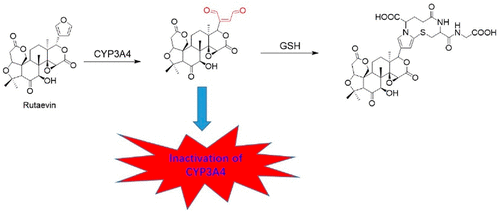当前位置:
X-MOL 学术
›
Chem. Res. Toxicol.
›
论文详情
Our official English website, www.x-mol.net, welcomes your feedback! (Note: you will need to create a separate account there.)
Cytochrome P450 Mediated Bioactivation of Rutaevin, a Bioactive and Potentially Hepatotoxic Component of Evodia Rutaecarpa
Chemical Research in Toxicology ( IF 3.7 ) Pub Date : 2020-12-11 , DOI: 10.1021/acs.chemrestox.0c00475 Yutao Liu 1 , Chang Liu 2 , Yamei Liu 2 , Quanli Ge 3 , Chen Sun 4
Chemical Research in Toxicology ( IF 3.7 ) Pub Date : 2020-12-11 , DOI: 10.1021/acs.chemrestox.0c00475 Yutao Liu 1 , Chang Liu 2 , Yamei Liu 2 , Quanli Ge 3 , Chen Sun 4
Affiliation

|
Rutaevin is one of the major bioactive constituents isolated from Evodia rutaecarpa, a well-known herbal medicine that has been widely prescribed for the treatment of gastrointestinal disorders in China. However, oral administration of rutaevin has been shown to cause hepatotoxicity in mice. Bioactivation was suggested to be involved in rutaevin-induced hepatotoxicity. The aim of this study was to investigate the bioactivation of rutaevin in rat and human liver microsomes fortified with NADPH. Rutaevin was metabolized into the reactive intermediate cis-butene-1,4-dial (BDA) that was dependent on NADPH. The rutaevin-derived BDA intermediate was trapped by nucleophiles such as glutathione (GSH), N-acetyl-lysine (NAL), and methoxylamine (MOA) in the microsomal incubation system. A total of 10 conjugates resulting from the conjugation of the intermediate with GSH, NAL, or MOA were detected and structurally characterized by liquid chromatography combined with high-resolution tandem mass spectrometry. M1, structurally confirmed by NMR spectroscopic analysis, was identified as a cyclic mono(GSH) conjugate of the BDA intermediate, which was also found in the biliary samples of rutaevin-treated rats. Further inhibitory experiments suggested that ketoconazole showed strong inhibitory effect on the formation of the rutaevin-derived BDA intermediate. CYP3A4 was demonstrated to be the major enzyme responsible for rutaevin bioactivation by using cDNA-expressed human recombinant cytochrome P450 enzymes. Additionally, it was found that rutaevin was a mechanism-based inactivator of CYP3A4, with inactivation parameters of KI = 15.98 μM, kinact = 0.032 min–1, and t1/2 inact = 21.65 min. In summary, these findings are of great significance in understanding the bioactivation mechanism of rutaevin, the potential mechanism of rutaevin-caused hepatotoxicity, and the drug–drug interactions associated with rutaevin mainly via CYP3A4 inactivation.
更新日期:2020-12-21














































 京公网安备 11010802027423号
京公网安备 11010802027423号